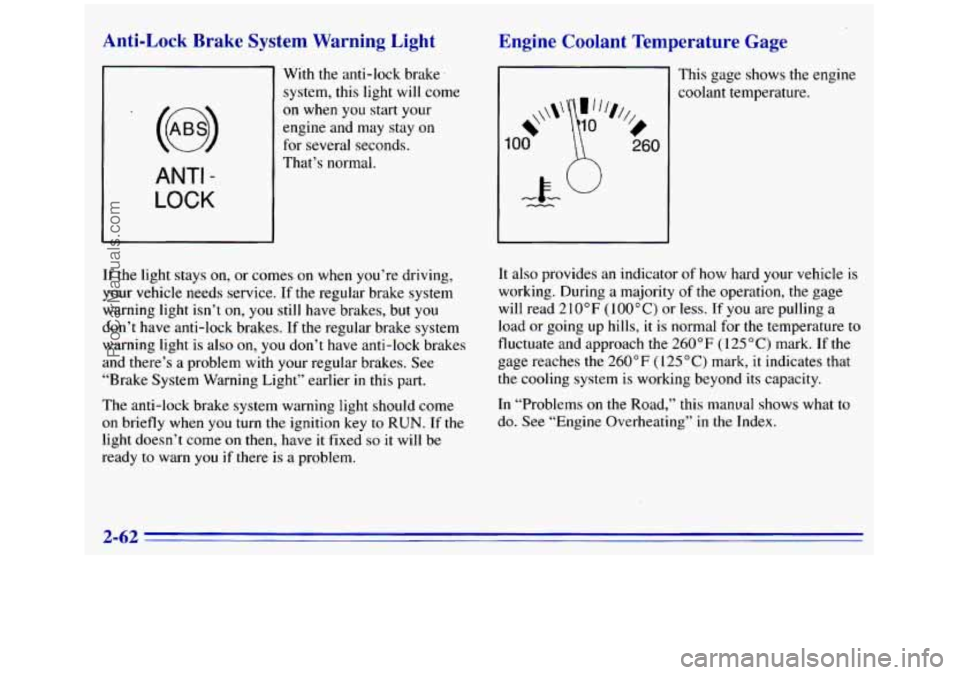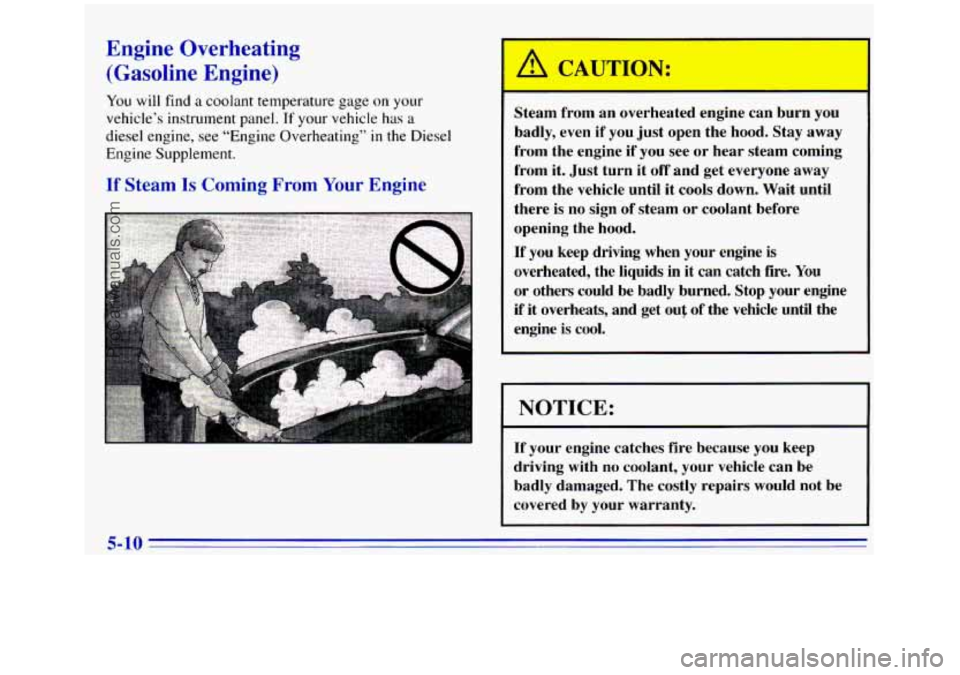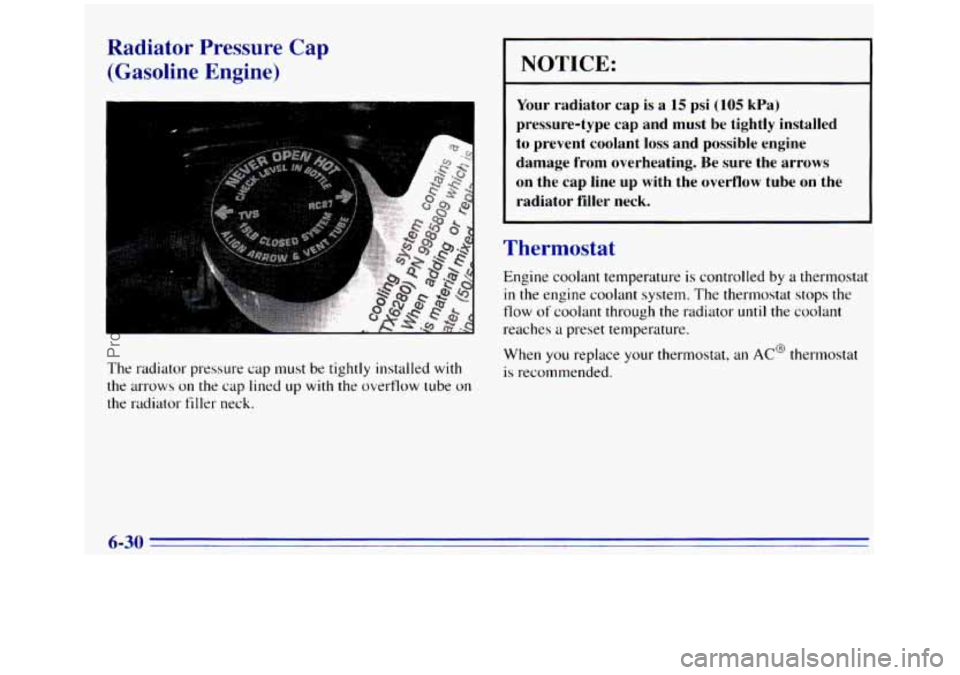1996 GMC SIERRA overheating
[x] Cancel search: overheatingPage 124 of 404

ANTI -
LOCK
Qnti-Lock Brake System Warning Light
With the anti-lock brake.
system, this light will come
on when
you start your
engine and may stay on
for several seconds.
That’s normal.
If the light stays on, or comes on when you’re driving,
your vehicle needs service.
If the regular brake system
warning light isn’t on,
you still have brakes, but you
don’t have anti-lock brakes.
If the regular brake system
warning light is also on, you don’t have anti-lock brakes
and there’s
a problem with your regular brakes. See
“Brake System Warning Light” earlier
in this part.
The anti-lock brake system warning light should come
on briefly when you turn the ignition key to RUN. If the
light doesn’t come on then, have it fixed so it will be
ready to warn
you if there is a problem.
Engine Coolant Temperature Gage
I This gage shows the engine
~ coolant temperature.
It also provides an indicator of how hard your vehicle is
working. During a majority of the operation, the gage
will read 210°F
(100°C) or less. If you are pulling a
load or going up hills, it is normal for the temperature to
fluctuate and approach the 260°F ( 125 “C) mark. If the
gage reaches the 260°F
(I 25 “C) mark, it indicates that
the cooling system is working beyond its capacity.
In “Problems
on the Road,” this manual shows what to
do. See “Engine Overheating” in the Index.
2-62
ProCarManuals.com
Page 211 of 404

Turn Signals When Towing a Trailer
The green arrows on your instrument panel will flash
whenever
you signal a turn or lane change. Properly
hooked up, the trailer lamps will also flash, telling other
drivers you’re about to turn, change lanes or stop.
When towing a trailer, the green arrows
on your
instrument panel will flash for turns even
if the bulbs on
the trailer are burned out. Thus, you may
think drivers
behind
you are seeing your signal when they are not. It’s
important to check occasionally to be sure the trailer
bulbs are
still working.
Driving On Grades
Reduce speed and shift to a lower gear be~m you start
down
a long or steep downgrade. If you don’t shift
down,
you might have to use your brakes so much that
they would get hot and
no longer work well.
On a long uphill grade,
shift down and reduce your
speed
to around 45 mph (70 km/h) to reduce the
possibility
of engine and transmission overheating.
If you have an automatic transmission, you should use
THIRD
(3) (or, as you need to, a lower gear) when
towing a trailer. Operating your vehicle in THIRD
(3)
when towing a trailer will minimize heat build-up and
extend
the life of your transmission
If
you have a manual transmission and you are towing a
trailer,
it’s better not to use FIFTH (5) gear. Just drive in
FOURTH (4) gear (or, as you need to, a lower gear).
When towing at high altitude on steep uphill grades,
consider the following: Engine coolant will boil at a
lower temperature than at normal altitudes. If
you turn
your engine off‘ immediately after towing at high altitude
on steep uphill grades, your vehicle may show signs
similar
to engine overheating. To avoid this, let the
engine
run while parked (preferably on level ground)
with the automatic transmission
in PARK (P) (or the
manual transmission out
of gear and the parking brake
applied) for a few minutes before turning
the engine off.
If you do get the overheat warning, see “Engine
Overheating’’
in the Index.
ProCarManuals.com
Page 226 of 404

Engine Overheating
(Gasoline Engine)
You will find a coolant temperature gage on your
vehicle’s instrument panel.
If your vehicle has a
diesel engine, see “Engine Overheating” in the Diesel
Engine Supplement.
If Steam Is Coming From Your Engine
A CAUTION:
Steam from an overheated engine can burn you
badly, even if you just open the hood. Stay away
from the engine if you see
or hear steam coming
from it. Just turn it
off and get everyone away
from the vehicle until it cools down. Wait until
there is no sign
of steam or coolant before
opening the hood.
If you keep driving when your engine is
overheated, the liquids in it can catch
fire. You
or others could be badly burned. Stop your engine
if it overheats, and get out of the vehicle until the
engine is cool.
NOTICE:
If your engine catches fire because you keep
driving with no coolant, your vehicle can be
badly damaged. The costly repairs would not be
covered by your warranty.
5-10
ProCarManuals.com
Page 276 of 404

Front Axle
When to Check and Change Lubricant
Refer to the Maintenance Schedule to determine how
often
to check the lubricant and when to change it. See
"Scheduled Maintenance Services"
in the Index.
How to Check Lubricant
If the level is below the bottom of the filler plug hole.
you'll
need to add some lubricant.
If the differential is at operating temperature (warm),
add enough lubricant
to raise the level to the bottom of
the filler plug hole.
If the differential is cold, add enough lubricant to raise
the level
to 1/2 inch (1 2 mm) below the filler plug hole.
What to Use
Refer to the Maintenance Schedule to determine what
kind
of lubricant to use. See "Recommended Fluids and
Lubricants"
in the Index.
Engine Coolant
The cooling system in your vehicle is filled with new
DEX-COOL
TM (orange-colored, silicate-free) engine
coolant. This coolant is designed
to remain in your
vehicle for
5 years or 100,000 miles (1 66 000 km),
whichever occurs first.
The following explains
your cooling system and how
to add coolant when it is low. If you have a problem
with engine overheating, see "Engine Overheating"
in
the Index.
6-26
ProCarManuals.com
Page 280 of 404

Radiator Pressure Cap
(Gasoline Engine)
The radiator pressure cap must be tightly installed with
the arrows on the cap lined LIP with the overflow tube on
the radiator filler neck.
NOTICE:
Your radiator cap is a 15 psi (105 kPa)
pressure-type cap and must be tightly installed
to prevent coolant
loss and possible engine
damage from overheating. Be sure the arrows
on the
cap line up with the overflow tube on the
radiator filler neck.
Thermostat
Engine coolant temperature is controlled by a thermostat
in the engine coolant system. The thermostat stops the
flow of coolant through the radiator until the coolant
reaches
a preset temperature.
When you replace your thermostat, an AC@ thermostat
is recommended.
6-30
ProCarManuals.com
Page 298 of 404

Tires
We don’t make tires. Your new vehicle comes with
high-quality tires made by a leading tire manufacturer.
If you ever have questions about your tire warranty and
where
to obtain service, see your GM Warranty bookJet
for details. Poorly maintained and improperly used tires
are dangerous.
0
0
0 0
Overloading your tires can cause overheating
as a result of too much friction. You could
have an airout and a serious accident. See
“Loading Your Vehicle”
m the Index.
Underinflated tires pose the same danger as
overloaded tires. The resulting accident
could cause serious injury. Check all tires
frequently to maintain the recommended pressure. Tire pressure should be checked
when your tires are cold.
Overinflated tires are more likely to
be
cut, punctured or broken by a sudden
impact
-- such as when you hit a pothole.
Keep tires at the recommended pressure.
Worn, old tires can cause accidents.
If your
tread is badly worn, or if your tires have
been damaged, replace them.
ProCarManuals.com
Page 394 of 404

Engine ................................... 6.8. 6.10
Coolant
..................................... 6-26
Coolant Heater
............................... 2- 12
Coolant Level Check
.......................... 7-42
Coolant Temperature Gage
..................... 2-62
Cooling System Capacity
....................... 6-76
Exhaust
..................................... 2-30
Fuse Blocks
............................ 6.69. 6.71
Identification
................................ 6-67
OilLevelCheck
.............................. 7-42
Overheating
................................. 5- 10
Running While Parked ......................... 2-30
Specifications
................................ 6-74
StartingYour
................................ 2-11
Underhood Fusemelay Center
................... 6-7 I
Engine Oil .................................... 6- 12
Adding
..................................... 6-13
Additives
................................... 6-15
Checking
................................... 6-12
Pressure Gage
................................ 2-65
Used
....................................... 6-16
Whentochange
.............................. 6-15
Exhaust. Engine
................................ 2-30
Fabric Cleaning
............................... 6-59
Fan Control. Climate Control System
............ 3.1. 3.2
Fender Marker Lamp Bulb Replacement
............. 6-42
FillingYourTank
................................ 6-4
Filter. Air
..................................... 6-16
Finish Care
.................................... 6-63 Finish Damage
................................. 6-64
Flashers. Hazard Warning
......................... 5-1
Flat Tire. Changing
............................. 5-21
Fluid Capacities
................................ 6-76
Fluids and Lubricants
............................ 7-48
FogLamps
.................................... 2-41
Foreign Countries. Fuel
........................... 6-4
Four-wheel Drive
......................... 2-21. 6-25
French Language Manual
11
FrontAxle .................................... 6-26
Front Axle Locking Feature
....................... 2-21
FrontTowing
................................... 5-9
Front Turn Signal Lamp Bulb Replacement
..... 6.40. 6.41
Fuel
.......................................... 6-2
Filling Your Tank
.............................. 6-4
Gage
....................................... 2-68
In Foreign Countries
........................... 6-4
Tankcapacity
............................... 6-76
Fuses and Circuit Breakers
....................... 6-69
Fusible Links
.................................. 6-69
.. ...........................
Gages Engine Coolant Temperature
.................... 2-62
Engine Oil Pressure
........................... 2-65
Fuel
....................................... 2-68
Tachometer
.................................. 2-57
Voltmeter
................................... 2-60
Garage Door Opener
............................ 2-46
GAWR
....................................... 4-42
Speedometer
................................. 2-57
9-4 ..
I
ProCarManuals.com
Page 397 of 404

Mirrors ....................................... 2-43
Convex Outside
.............................. 2-46
Inside Day/Night Rearview
..................... 2-43
Manual
..................................... 2-45
Power Remote Control
......................... 2-45
Model Reference
................................. vi
MountainRoads ................................ 4-36
Electrochromic
bay/Night Rearview
.............. 2-44
MMT
......................................... 6-3
New Vehicle Break-In ........................... 2-8
Nightvision
................................... 4-29
Noise Control System
........................... 6- 1 1
Odometer .................................... 2-57
Odometer
. Trip ................................. 2-57
Off-Road Driving
.............................. 4- I3
Off-Road Recovery
............................. 4- IO
Oil. Engine .................................... 6-12
Overheating Engine
............................. 5- IO
Owner Checks and Services ....................... 7-42
Owner Publications. Ordering
...................... 8-9
Opener.
Garage Door
............................ 2-46
Paint Spotting. Chemical
........................ 6-65
Park. Shifting Into
.............................. 2-26
Parking AtNight
..................................... 2-8
Brake
...................................... 2-25 Brake Mechanism Check
....................... 7-45
Over Things That
Burn ........................ 2-29
With
a Trailer ................................ 4-58
Your Vehicle. Manual Transmission
.............. 2-29
Passenger Position
.............................. 1-28
Passing
....................................... 4-11
Periodic Maintenance Inspections .................. 7-46
Power Accessory
Outlet ............................. 2-53
DoorLocks
................................... 2-5
Driver’sSeat
................................. 1-2
Option Fuses
................................ 6-68
Remote Control Mirror ........................ 2-45
Steering
Fluid ................................ 6-31
Take-Off
.................................... 4-60
Winches
.................................... 4-60
Windows
................................... 2-31
Pregnancy, Use
of Safety Belts .................... 1-27
Problems on the Road
............................ 5-1
PTO ......................................... 4-60
Publications. Service and Owner
.................... 8-9
Lots ........................................ 2-8
Steering
..................................... 4-8
Radiator
..................................... 5-17
Radiator Pressure Cap
........................... 6-30
RadioReception
................................ 3-23
Radios
........................................ 3-6
Rain. Driving
In ................................ 4-30
Reading
Lamps ................................ 2-42
9-7
ProCarManuals.com